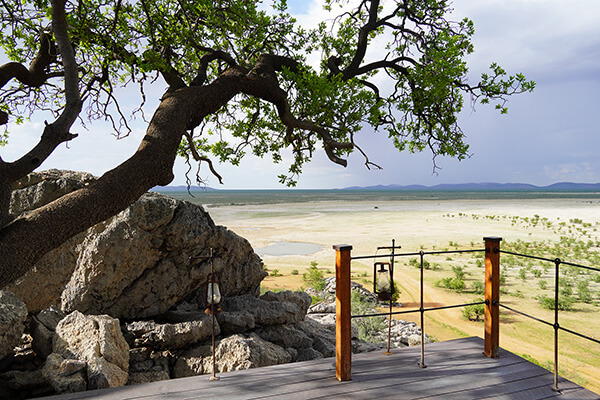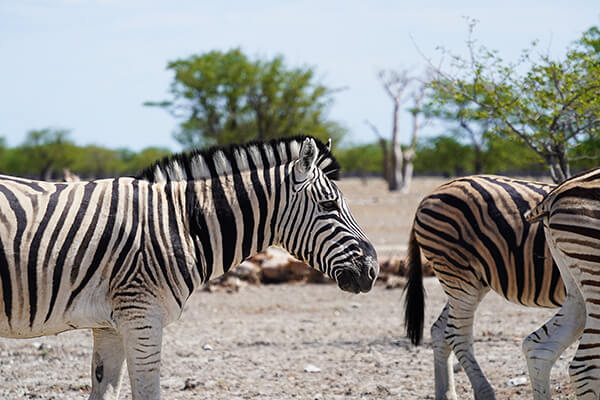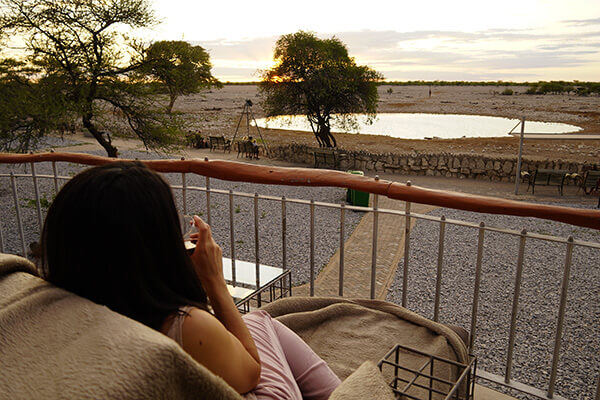Self-Driving Safari
Self-Driving Safari
in Etosha National Park
Day 1: Western Area
Previously limited to research and conservationists, the western side of the park can provide a quieter, more secluded experience. With limited accommodation options and a half day’s drive to the Etosha Pan, this area doesn’t entertain quite as many visitors. It is still teeming with wildlife, admittedly less than the pan areas. So it’s a great way to ease into the park and explore a sight less seen.
Where to Stay:
Dolomite Camp (luxury)
Olifantsrus Campsite (budget)
Day 2: Okaukuejo Area
This is the area of the park where you have the best chance of seeing lions. While we found the sightings book somewhat unhelpful, it can be useful for a pride of lions who are more likely to stay put in their resting area most of the midday. The Okaukuejo waterhole was visited by the elusive black rhino each evening we were there, which was a real treat. It’s also great and convenient for very early morning and night waterhole viewing to try to catch predators starting or ending their day with a drink, as the waterhole is within the enclosed borders and walkable from all types of accommodation.
Where to Stay:
Okaukuejo Resort (camp, room, or chalet for all budgets)
Budget Option: A resort or lodge outside Andersson’s Gate. There is a 45 minute drive on a tarred road into
the main viewing roads of the park, but there is still wildlife to see along the way and you get more bang for your
buck in accommodations outside the park.
Day 3: Halale Area / Mid-Salt Pan
This is the area of the park where you have the best chance of seeing Black Rhinos.
The waterhole for the Halale Resort is a further walk and a bit smaller than at Okaukuejo, but if offers comfortable, shaded viewing. You can also drive into it if you aren’t for taking a walk, as there is limited adjacent parking.
It’s worth driving out to the salt pan viewing area. There were no cars when we went and it is a unique view in the middle of a vast salt pan expanding to the horizon in before you.
Day 4: Namutoni Area
We enjoyed the drive around the Fisher's salt pan. It was less traveled, in general, and at one point we got amazing wildlife views of elephants, zebras, wildebeasts, giraffes, and springboks grazing in the same area, making for a great photograph.
Day 5: Onkoshi Camp
Explore the eastern, semi-secluded area of the main salt pan. It offers lovely and quiet views of the salt pan. You will likely see less wildlife here, as we’ve noted less animals on and close to the salt pan than otherwise, in exchange for a more secluded experience without as far of a drive as Dolomite.
Etosha in Four Days
Skip Onkoshi Camp, as you’ve had plenty of time viewing the salt pan as you drive through the park. You will still get the secluded experience you crave by visiting Dolomite. If you aren’t necessarily interested in a more secluded experience and want to maximize wildlife viewing, skip both Dolomite and Onkoshi and stay an extra day in the Okaukuejo area.
Etosha in Three Days
Stick to a night each in the Okaukuejo, Halale, and Namutoni areas. Spend the mornings and evenings on game drives and, if you’re up for it, even the mid-day. With limited time in each area, you’ll want to spend as much time on the road as you can. There are plenty of waterholes to visit.
Suggested Alternatives
If you don’t like hopping accommodations, the main salt pan is drivable within a (long) day. Consider multiple nights at the same resort. Because wildlife is unpredictable, driving over the same area can yield different wildlife experiences. And you can spend time comfortably viewing the resort waterhole in the shade at any time. There are many roads to cover, and you can easily create different game drives each day.
Self Driving vs. Guided Game Drive
Self Driving
Self driving is a great option! Choose your routes, stay or move on as you like, enjoy air conditioning, and cover all the same areas as the guided drives… so no chance of FOMO.
- Head out very early, like at the first sign of sunrise. Mornings and evenings are the best times for animal viewings, but early mornings are especially the best for some of the more elusive predators who are active at night.
- A four wheel drive is not necessary to self-explore Etosha.
- A tented vehicle is not necessary—all campsites are enclosed.
- Most roads are in great condition, either paved or dirt. However, some areas can be a bit ripply or uneven. To lower your chances of a flat tire, reduce your tire pressure on dirt roads and drive under the 60km speed limit.
- Bring plenty of water and snacks. Even with AC the heat can be rough and you may find you’re out longer than you anticipated.
Guided Game Drive
With a guided drive, all guests can have constant opportunities for views and pictures, with no designated driver necessary. With open air vehicles, views are more open and make for better picture taking.
- Prioritize morning and evening game drives. Not only are they much more comfortable temperature-wise, you’re more likely to see animal activity and more elusive predators.
- Midday drives can still provide great animal sightings at waterholes, but be prepared for unpleasant weather in open air vehicles.
How to Get There
- Rent a car and self drive from Windhoek. A four wheel drive or tented vehicle is not necessary.
- Arrange transportation from Windhoek to your accommodations, and book guided game drives.
- Book a guided tour from Windhoek.
What to Pack
Necessities:
- Sun hat
- Sunscreen
- Sunglasses
- Binoculars
- Bug spray
- Long sleeve layer for cooler nights and bug protection
- UV protected clothing/sleeves
- Double wall water bottle
Optional:
- Conditioner
- Tampons or menstrual cup
- Tire pressure gauge for self-driving
- Bathing suit
- Rain gear
General Information
General Contact Information
Central Reservations - Windhoek:
Phone: +264 (0) 61 285 7200
Emergency after hours: +264 (0) 81 143 6950
Email: reservations@nwr.com.na
Direct Contact Information
Dolomite Camp: +264 (0) 65 685 119
Olifantsrus: +264 (0) 61 285 7200
Okaukuejo Resort: +264 (0) 67 229 800
Halali Resort: +264 (0) 67 229 400
Namutoni: +264 (0) 67 229 300
Onkoshi: +264 (0) 85 5502 342
- Bookings can take 48 hours to confirm, but expect potentially delayed or even no response.
- Server problems make web bookings often unavailable. Suggest trying again later rather than reserving via email if time is a factor or there is limited availability.
Petrol Stations
Petrol stations can be found within the Park at Okaukuejo, Halali and Namutoni.
All had diesel but were out of petrol. Instead, gas up full prior to entering or fill up at the Trading Post just outside Andersson’s Gate.
Resorts (from west to east)
Dolomite Camp
Ten campsites, eight guests per site. Features ablutions and a kiosk with beverages and light meals.
- All rooms have lovely views of the park given the hilltop location; however, most cannot view the waterhole. If you are opting for a deluxe room, request chalet #23, as it is the only option with a waterhole view. The regular chalets surrounding chalet #23 may also have partial waterhole views, but this isn’t verified.
- Lower numbered rooms are closer to common areas, making them more walkable if you don’t want to prearrange golf cart transport.
The camp is not enclosed. It is located on a rocky hilltop, but wildlife can still wander through. A staff member told me you have to mostly be careful of poisonous snakes (which can be very dangerous in Africa), but they have also seen a leopard wander through the camp. That is why you are not allowed to walk the resort after dark, and must be transported via golf cart. Note that if you are in your room after dark, there is no way to call a golf cart, so pre-arrange any transport from your chalet to the common areas prior.
Olifantsrus Campsite
Lower numbered rooms are closer to common areas, making them more walkable if you don’t want to prearrange golf cart transport.
This was closed in early December 2023, although it did not say so on the park website, so this campsite might be seasonal.
Okaukuejo Resort
The only property with a post office… that was not open the three weekdays we were there.
If you are opting for a waterhole chalet, it’s worth viewing before check in and requesting a specific chalet. They don’t tell you, but most have some sort of obstructed view from trees or lampposts. Chalets #34 and #35 had what seemed like the most open views, with #34 obstructed on the left side of the waterhole by a tree, and #35 having lampposts in front that are not big obstructions but will be captured in a photograph from the balcony.
- The balconies have umbrella bases, so request an umbrella to be set up. There is no shade on the balcony and the sun can be brutal.
- There is no room service, but we were able to get our dinners to go and enjoy them in our rooms with a view of the waterhole at sunset, which was far preferable to eating in the restaurant, and maximized the value of the chalet and our peak waterhole viewing time. They only asked that we returned the plates and silverware to the restaurant the next day.
Halali Resort
This is centrally located on the main salt pan. From a location standpoint, it’s a great place to spend multiple nights instead of resort hop as you have easier access to all areas of the pan. That said, we did not stay here and opted to spend two nights in the Okaukuejo resort instead because of the waterhole view chalet option. The accommodation in Okaukuejo also generally looked nicer from the website photos than Halali. Halali offers camping and lodging, and the waterhole viewing area was elevated and shaded, although a bit of a walk from the lodging and camp.
Onkoshi Camp
Budget Option: There are several accommodation options outside the Andersson and Vondlinquist Gates where you may get more for your money.
- Each resort has a sightings book you can check out before heading out on a self-guided game drive, but curb your expectations as we didn’t find them super helpful, except for a lion pride which is much less likely to be on the move.
- Each resort offers morning, afternoon, and evening game drives, but they don’t explore any areas you can’t self drive to.














